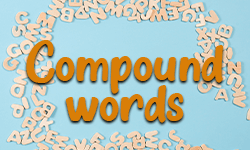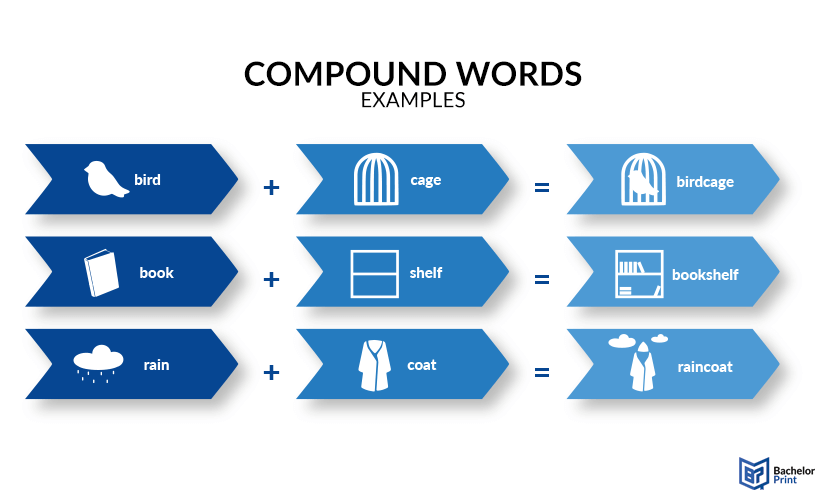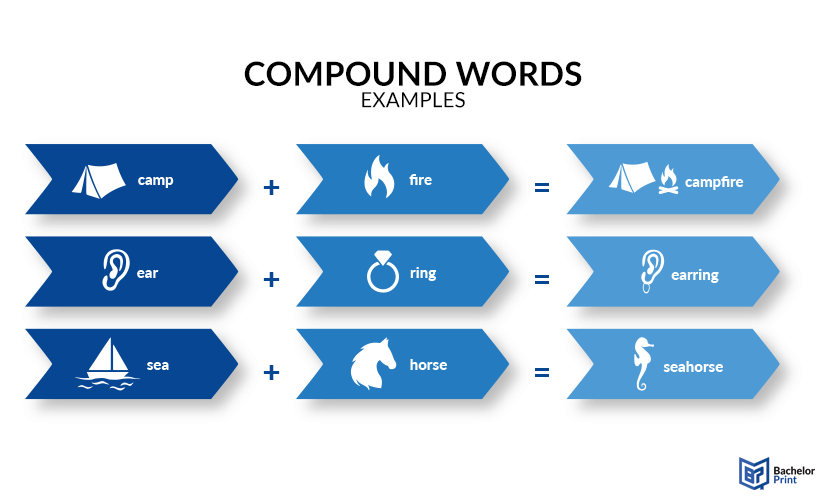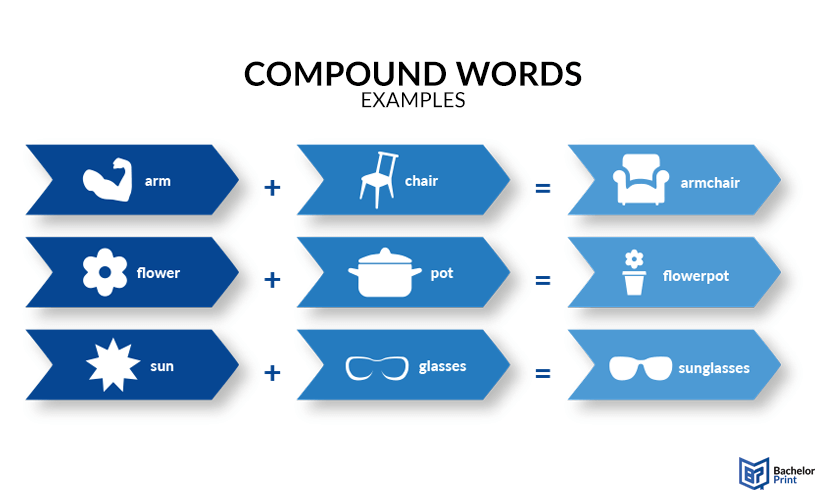
Compound words are a fascinating cornerstone of language, blending two or more words to create new meaning. These combinations follow unique language rules that govern their formation—rules that often strike a balance between creativity and clarity. Understanding how compound words function unlocks a deeper appreciation for language structure and empowers us to use them effectively. Let’s explore the types, rules, and examples that bring them to life.
Definition: Compound words
In linguistics, English compound words are formed when two or more words are combined to function as a single unit. These hybrid words can be written in three forms: closed (e.g., birthday), hyphenated (e.g., mother-in-law), or open (e.g., ice cream).
Compound expressions also take on different grammatical roles as nouns (e.g., toothbrush), verbs (e.g., sleepwalk), adjectives (e.g., well-known), adverbs (e.g., nevertheless), or prepositions (e.g., in front of), depending on how they function in a sentence.
Types of compound words
In English grammar, compound words can be categorized based on their form, their meaning, and their parts of speech. Each category, along with their subtypes, is explained in detail below.
Compound words based on form
The three different categories of compound words will be explained below, along with examples.
Closed compound words are joined together with no spaces.
Hyphenated compound words are, as the name suggests, connected with a hyphen.
These words remain separate but are used together as a single concept.
Compound words based on meaning
Below, we’ll explore the four categories of compound words and provide examples to clarify each type.
These meanings are clear and directly relate to the individual parts of the word.
These meanings are external and not directly derived from the components as the root word “exo-,” meaning “outside” suggests.
Also known as coordinative compounds, both parts contribute equally to the meaning.
Both components describe the same thing in different ways.
Compound words based on parts of speech
The following section will outline the three categories of compounds words based on parts of speech.
A compound noun represents a person, place, thing, or concept.
A compound adjective modifies a noun.
A compound verb represents an action or state.
A compound adverb modifies a verb, adjectives, or another adverb.
Compound prepositions indicate relationships in time, place, direction, or space.
Compound conjunctions join clauses, phrases, or words together.
A compound determiner modifies nouns to specify quantity or possession.
Examples
As societies evolved, so did their vocabulary. Instead of inventing entirely new words, early speakers combined existing ones. Many sentences with English compound words are listed below.
Below, you’ll find three visuals with numerous examples of compound words.
Rules and guidelines
Now that we know the types and rules, we are faced with several questions about compound words:
- When should I use a hyphen?
- Should I separate each constituent, or should I write them together without a space?
Before we get into what to do and what not to do, it is imperative to discuss the differences between British English vs. American English. British dictionaries (OED) and speakers and American dictionaries (Merriam-Webster) and speakers have different relationships when it comes to hyphens. While BE tends to put hyphens between the prefix and the base verb, AE prefers closed compound words, e.g., co-worker and coworker, or pre-school and preschool. Due to the favoured use of online dictionaries nowadays, lines between BE and AE regarding compound word spelling may blur depending on which online dictionary writers use.
Avoid ambiguity
Especially in compound adjectives, the use of hyphens is essential for clarity. While hyphenation is considered compulsory in BE, it is often optional in AE. However, it becomes necessary in both variants to prevent ambiguity or to assist the reader in understanding the intended meaning.
In the first example, “re-cover” means “to cover again,” while “recover” means “to heal.” This spelling mistake leads to confusion due to the missing hyphen.
“High-school teacher” refers to a teacher who works at a high school. The hyphen makes it clear that “high-school” is a compound adjective modifying “teacher.” Without the hyphen, it could mistakenly imply a school teacher being intoxicated. However, in this case, both versions can be used or “high schoolteacher.”
The term “coworker” is commonly written without a hyphen in American English, while British English is more likely to use the hyphenated variant for clarity. Without the hyphen, someone might accidentally read it as “cow-orker” before doing a mental double-take.
The last example features an “ice-axe,” an axe for mountaineering. Without the hyphen, it could be mistaken for an “axe made of ice.” These examples show that sometimes it is better to use hyphens, so that readers don’t misinterpret your work.
Avoid false scent
The term “false scent” in the context of writing refers to situations where the intended meaning of a sentence is unclear or misleading due to improper structure, such as missing hyphens, which can lead readers to “sniff out” the wrong interpretation of a sentence by pausing and re-reading.
Without the hyphen, the phrase can suggest that the “a” refers directly to the following noun “middle,” causing the reader to re-read the sentence to make sense of it. With the hyphen, the focus shifts to “attitude,” which correctly indicates that he has an attitude characteristic of the middle class.
The first two sentences can be misinterpreted as the business owner being short (which might be true), while the hyphenated “small-business” makes it clear that he is in fact the owner of a small business. So, whether the businessman is short or not, be sure to hyphenate and use spaces correctly.
Evolution of compound words
Initially, many compound words are hyphenated to make the connection between the parts clear, especially with new terms. As the term becomes widely used, the hyphen often disappears, which results in a single, closed compound or open compounds. Several examples can be seen below.
Compound numbers
Compound numbers are multi-word numbers that are normally written with a hyphen to join two or more parts into a single compound. Numbers between 21 and 99 and fractions should generally be hyphenated. Multiples of ten and numbers under twenty-one, however, do not require hyphens. The compound word “fifty-fifty” is an exception since it is commonly used as an idiom.
Many style guides like the Chicago Manual of Style or MLA use a hyphen to link numbers consisting of combinations of tens and ones (fifty-nine), but not numbers in the hundreds (two hundred), thousands, etc.
Fractions
When fractions function as compound adjectives or nouns, hyphens should always be used.
Ages
Just like fractions, use hyphens when ages describe something or stand alone as a noun.
There are plenty of rules, as we can see. Generally, you can say that a compound adjective before a noun should be hyphenated, while you should leave it open after a noun. If a compound adjective contains an adverb with an “-ly” ending, leave it open. And when there is no risk of ambiguity or false scent, don’t hyphenate.
But don’t stress too much, after all, John Benbow humorously remarked in Manuscript and Proof (1937):
“If you take hyphens seriously you will surely go mad.”
- ✓ Free express delivery
- ✓ Individual embossing
- ✓ Selection of high-quality bindings
Compound words vs. portmanteaus
A portmanteau is a stylistic device that blends parts of two or more words into one, e.g., brunch, smog, and webinar. These examples show their differences, as compound words focus on combining existing words directly, while portmanteaus are more stylistic and creative.
Compound words in other languages
Compound words exist in numerous languages worldwide and typically reflect unique linguistic structures. Here’s a look at how these words function in other languages:
German
German is well-known for its compound words, so much so that some get adopted into the English language, such as “Schadenfreude,” which translates to “harm-joy” and refers to the joy one experiences from another’s misfortune. The German language allows unlimited word compounding to form specific terms, which can create expressive vocabulary. Some common examples can be found in the table below.
| First constituent | Die Kinder | Schreiben (verb) | Krank (adjective) |
| Second constituent | Der Garten | Der Tisch | Das Haus |
| Compound word | Der Kindergarten | Der Schreibtisch | Das Krankenhaus |
| Literal translation | The kids garden | The write table | The sick house |
| English translation | The kindergarten | The desk | The hospital |
Japanese
Japanese noun compound words are formed by combining kanji characters (logographic symbols) or by combining native Japanese words.
| First constituent | 火 (hi) | 電 (den) | 手 (te) |
| Second constituent | 山 (yama) | 車 (sha) | 紙 (kami) |
| Compound word | 火山 (kazan) | 電車 (densha) | 手紙 (tegami) |
| Literal translation | Fire mountain | Electricity vehicle | Hand paper |
| English translation | Volcano | Train | Letter |
Spanish
Unlike English compound words, Spanish ones typically don’t use hyphens or spaces. Once a new word becomes established, it is written as a single, closed compound, which is a hallmark of Spanish compounding.
| First constituent | Abrir (verb) | Parar (verb) | Tela |
| Second constituent | Latas | Aguas | Araña |
| Compound word | Abrelatas | Paraguas | Telaraña |
| Literal translation | Opens cans | Stop waters | Fabric spider |
| English translation | Can opener | Umbrella | Spiderweb |
FAQs
A compound word is a word formed by combining two or more individual words to create a new word with its own meaning. These can appear written as one word (website), written as two separate words (high school), or joined by a hyphen (eye-catching).
Closed compounds
- Notebook
- Firefly
- Toothbrush
- Rainbow
- Classroom
Open compounds
- Ice cream
- Living room
- Post office
- High school
- Coffee table
Hyphenated compounds
- Mother-in-law
- Well-being
- Check-in
- Long-term
- Merry-go-round
These words are made up of two or more different words to create a new word. Some examples:
- Sunflower (sun + flower): A bright, yellow flower.
- Butterfly (butter + fly): A colorful flying insect.
- Snowman (snow + man): A man made of snow.
- Playground (play + ground): An area where kids play.
- Bedroom (bed + room): A room for sleeping.
- Treehouse (tree + house): A house built in a tree.
They should be hyphenated…
- To avoid ambiguity:
Example: Man-eating shark vs. man eating shark.
- As modifiers before a noun:
Example: Well-known author. (Before a noun)
No hyphen: The author is well known. (After the noun)
- With numbers and fractions:
Example: Twenty-one students, three-fourths full.
- With certain prefixes:
Example: Re-cover (cover again) vs. recover (heal).


